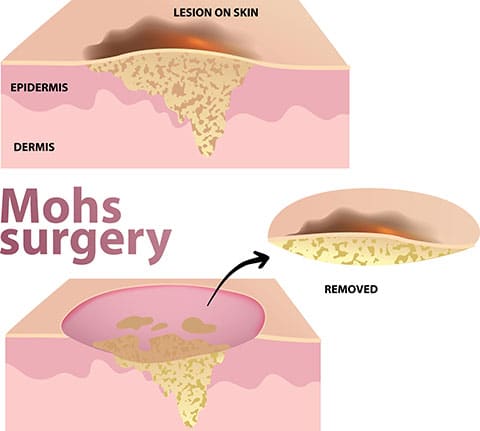New York Center for Facial Plastic Surgery
Schedule a consultation

Information About Mohs Reconstructive Surgery with Dr. Andrew Jacono in New York, NY

Mohs micrographic surgery (MMS) removes malignant lesions and cancer cells. Layers of skin tissue are meticulously removed and examined under a microscope. By removing tissue incrementally, the physician can ensure that all affected tissue has been excised.
Of all surgical techniques available today, Mohs surgery offers the lowest recurrence rate of malignant cells. It also preserves the healthiest tissue. It is usually performed by specialized dermatological surgeons who only perform skin cancer removal. These physicians then refer patients to facial plastic surgeons, like Dr. Jacono, for reconstruction.
Mohs surgery is more expensive and time-consuming than traditional excision. However, it is a good option for patients who have recurrent or aggressive carcinomas. It is also important for the treatment of cosmetically important areas like the nose, eyelids, and lips. Mohs surgery can remove basal cell carcinomas, squamous cell carcinomas, and other facial lesions.
After carcinomas are removed, a depression or hole is left behind. After treatment, dermatologists bandage the wound and send patients to Dr. Jacono’s office. This can be done on the day of surgery or the following day.
Once the bandage is removed and the defect is assessed, Dr. Jacono begins reconstruction. Most defects can be repaired with skin flaps, which move local tissue to cover the Mohs hole. In certain cases, full-thickness skin grafts may be necessary.
Sometimes, more complex reconstructions are required. This depends on how much tissue is removed, and whether other tissue must be reconstructed. Dr. Jacono specializes in these more complex skin cancer reconstruction surgeries.
New York Center for Facial Plastic Surgery
Schedule a consultation

Mohs surgery and plastic surgery are fundamentally different. Mohs surgery focuses on removing malignant tumors and lesions. Dermatological surgeons excise cancerous tissue and preserve healthy tissue.
Plastic surgery, on the other hand, focuses on reconstructing the face after Mohs surgery. This is because Mohs surgery leaves behind visible scars and holes.
Stitches on the face or neck are usually removed within 7-10 days. Stitches on the ears and scalp are usually removed after 14 days.
Mohs patients are usually immediately referred to Dr. Jacono for reconstructive surgery. Dermabrasion may be performed approximately 6 weeks after reconstruction.
Unfortunately, Mohs surgery leaves behind scars, holes, and depressions. This is because the removal of malignant lesions does not include reconstruction.
Luckily, facial plastic surgeons like Dr. Jacono specialize in Mohs surgery reconstruction. They have the ability to reverse scarring and other facial defects.
He is also part of Face to Face and is one of a small group of Facial Plastic and Reconstructive Surgery Specialists who volunteer their time to perform Reconstructive Surgery on women who are victims of domestic violence pro-bono.

This patient’s Mohs surgery left her without an upper lip. She underwent a bilateral transposition flap procedure. Upper lip defect reconstruction used borrowed cheek skin.


This patient lost nasal tissue after Mohs surgery. He underwent two-stage reconstruction using a pedicled paramedian forehead flap. This means that the flap stayed attached to the donor site. Dr. Jacono then sectioned the flap attachment.


This patient had holes in his nose and lower eyelid. He underwent a two-stage surgical procedure using a pedicled paramedian forehead flap. The inside of his nose was repaired with a septal flap, and cartilage was borrowed from his ear. The flaps were then sectioned.
The patient also underwent a two-stage pedicled Hughes Flap, which borrowed skin and cartilage from the upper eyelid.

This patient had Mohs surgery that left a hole in her nose. She underwent two-stage reconstruction surgery. Dr. Jacono used a pedicled cheek flap and ear cartilage graft to restore the nose’s natural curvature. He then sectioned the flap attachment.


This patient had Mohs surgery and was left with a depression in his upper lip. He underwent a bilateral transposition flap procedure. Dr. Jacono borrowed cheek skin to reconstruct the upper lip.

Mohs surgery left this patient with a hole in her nose. She underwent a glabellar (forehead) transposition flap procedure. She also had cheek advancement flap surgery.


Mohs surgery left this patient with a gaping hole in her forehead. She underwent orotrichea flap closure reconstruction with Dr. Jacono.

Mohs surgery left this patient with a large hole in her forehead. Dr. Jacono performed an O to T advancement flap procedure, borrowing tissue from along the hairline.

This patient’s Mohs procedure left him with a large hole in his nose. Dr. Jacono performed two-stage surgery using a pedicle paramedian forehead flap. He then sectioned the flap attachment. The results look entirely natural.

Mohs surgery left this woman with an exposed depression in her cheek and eyelid. Dr. Jacono performed a neck transposition flap procedure. He also performed a forehead and cheek rotation flap procedure. The results look natural.



Accessibility: If you are vision-impaired or have some other impairment covered by the Americans with Disabilities Act or a similar law, and you wish to discuss potential accommodations related to using this website, please contact our Accessibility Manager at (212) 570-2500 .